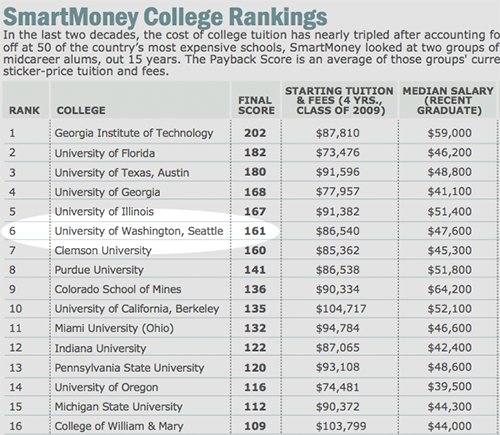A little validation for us Huskies from the folks at SmartMoney and their sources — The College Board; U.S. Department of Education and Payscale.com. It will be likely reassuring to UW students and parents who view college through an (arguably narrow) “vocational” lens.
While its intuitive that — holding all other variables as equal — graduates from more selective schools will earn higher salaries, it’s also clear that these schools cost a lot more. If you weigh those numbers against each other the way SmartMoney does, the Georgia Institute of Technology comes out on top in terms of ROI. The UW comes in 6th, Harvard ranks 24th and Yale is 33.

Before I get too smug here, it should be noted that PayScale did their own analysis in 2012, and depending on how you decide to sort their table, Georgia is still number one, and Harvard comes in 6th place. Then again it might be Harvey Mudd. In that latter scenario UW drops to 22 (Harvard is 21).
It should be recognized that the SmartMoney analysis assumes students are paying out of state tuition. Those paying local rates (about 40% the cost) benefit from a significantly higher return.

3 responses so far ↓
1 Steve Roth // Oct 16, 2012 at 6:52 am
I wonder how these rankings would sort out if the tuitions of UW (and other public university) students weren’t subsidized by the government.
Pondering it, I don’t think it’s a question that can really be answered, because the educational ecosystem would be completely different. The different game rules would result in a whole different set of complex interactive incentives etc.
You could just add (estimated) public tuition subsidies to these numbers to recalc the ROI, though.
2 Steve Broback // Oct 31, 2012 at 10:51 pm
Good point. The cost they list is for the pricey out of state tuition. Doubt the state taxpayers supplement that by much.
That being said, I don’t believe in a free lunch, so the state supplement must make a difference.
I’d also like to know what percentage of UW students pay even that low “list” price. Thanks to scholarships, and discounts/endowments given to individuals at both private and public schools, the entire pricing system is fracked nationwide. How many students at Harvard actually pay the full $58K? To what degree do they subsidize the others?
3 Steve Roth // Jan 8, 2013 at 10:50 am
” The cost they list is for the pricey out of state tuition.”
Ah. I didn’t realize that. I was about to tease you for considering yourself so clever, taking advantage of those subsidies. (Which you are doing, of course: taking advantage of them — not touting your cleverness for doing so. [Though you are clever to do so, especially compared to me.])
“Thanks to scholarships, and discounts/endowments given to individuals at both private and public schools, the entire pricing system is fracked nationwide. How many students at Harvard actually pay the full $58K? To what degree do they subsidize the others?”
Well “fracked” might be one word. Complex would another — like most markets that aren’t for standardized commodities with sufficient equal-market-power buyers and sellers and no institutions except a trading floor (and a Walrasian auctioneer…). Things end up being not at all obvious…
Leave a Comment